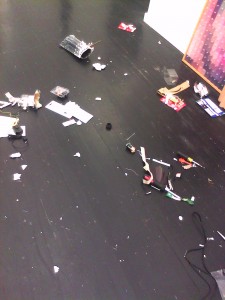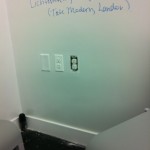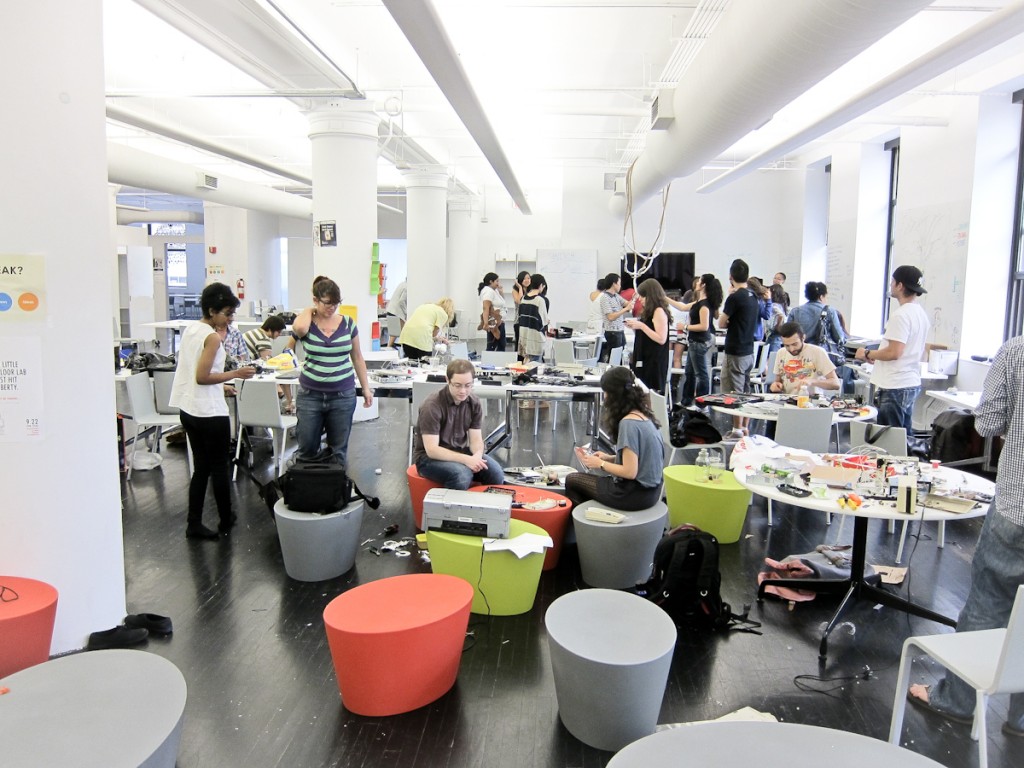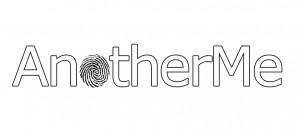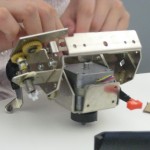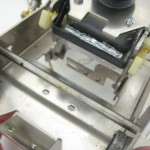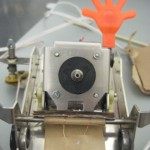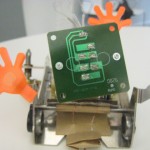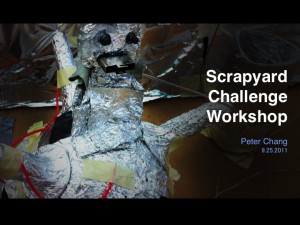If you missed the screening in class or need to review, here’s a link to William Whyte’s the Social Life of Small Urban Spaces on Vimeo
Monthly Archives: October 2011
Scrapyard Challenge – Reflection – Vanessa
Vanessa Roa September 28, 2011
Major Studio: Interface I D+T MFA
Assignment #4: Reflective on Scrapyard Challenge
Guiding Questions:
1.What kind of material affordances does your object provide? How does this influence the way in which another person would interact with your object? How have the affordances of your object changed from the original artifacts you started with?
2. Using the definition provided by Houde & Hill, is your object a prototype? Yes or No? What is your reasoning?
3. What is your understanding of the system image vs. the conceptual model of the workings of your artifact? How do they diverge?
4. How both specifically and in more general terms is the “electronic object” different from the “non-electronic object?” Do they differ at all?
Although I feel I made many mistakes, I learned quite a bit at the Scrapyard Challenge, including how to build an instrument that works with an input and power switch. After seeing what my other classmates made, I felt overwhelmed at the fact that I knew nothing about how to build anything and was surprised when my instrument worked. It seemed way more complicated than I had imagined, but it was an experience that I look forward to recreating. If I could do this experience all over again, I would have approached this by perhaps using some glue gun, or bringing more supplies with me. With that said, I don’t have any regrets, this was an enlightening experience. Plus, I learned how to soldier and make an instrument.
My object provides the affordance of creating musical notes by turning the hands of the clock to touch certain areas on the foil to produce a note. When I initially started my project, I came in with an abundance of materials, many of which I felt overwhelmed with, as I didn’t know what to do with all of the objects at my disposal. Overtime, those items dumbed down to one ugly broken clock with a dead battery and lots of tin foil (which was also, slowly wind down to one sheet). In reality, those two things were all I needed. With not much at our disposal, a group member of mine came up with a concept to use a clock that unbeknownst to her, was mine. I suggested perhaps gluing down the tin foil to the metal knobs so that it could pick up on the electric charge. We ended up using some PVC insulation tape and many many wires later, the clock went in for it’s first testing.
When I started with my project, my clock was simply broken and I was curious as to how I would be able to fix it. Considering that I haven’t really thought of how far along I was going to push the concept of my instrument when I was making it (just being able to complete it on time) At first, I contemplated whether my clock was a completed finished product, as is, or whether I would consider it a prototype. I think after much debate, I would say it’s definitely a prototype. If I could, I would have my clock play several different notes as you turned the hands, and rewire some of the hands so that it would be able to turn more easily. According to the definition laid out by Houde and Hill, my concept was simply an idea that was meant to lay out how it would be used by a designer to explore or demonstrate some aspect of the future artifact. Since I was only able to create the object to the extent that it played a note, it filled it’s purpose as a prototype, meant to express the idea of how it would be used should it have been developed further. If I were to have more time, I would adjust the weak aluminum foil and create more notes for the instrument to play.
I wondered what it would take to make my object run on electricity so that I could use it for it’s intended purpose. But then, I began to brainstorm; did my object stop being an electronic object because it wasn’t connected to an amp? I wondered what and where lied a difference between objects that stand alone on battery charged electricity and those that require some sort of electricity to be able to run. Much like my instrument, I saw a connection between the way most of my appliances and electronics ran through outlets as no different. I’m hoping to either buy an amp and create music on my own one day and hope to create a battery powered version of my model eventually. However, it would also require more work to create sounds on it’s own. It would be an idea worth both experimenting with and exploring.
Scrapyard Challenge – Arshaan
Everything done during the scrapyard challenge workshop was new to me. I have never worked with electronics before. However, once I got the basics it turned out to be a lot of fun. The fact that we could use junk to make new things in a creative way started to excite me once we started tearing apart the junk. In our day to day lives, not many people would think to use their junk to make new things. We would just throw it away. The things that everyone made during the workshop showed me that even if things stop working we can use them to make new things. They don’t have to be wasted.
The Project:
Me and my group had no idea what we wanted to make in the beginning and just started tearing apart whatever we had to find things that interested us. We started tearing apart old cordless phones, routers, floppy drives and a scanner.
 After a few minutes we decided that we would use the moving motor in the scanner (which was surprisingly working) to make sounds when the motor hit certain parts. However, Kenny told us that a few other groups were trying to do something similar and we decided to go another direction.
After a few minutes we decided that we would use the moving motor in the scanner (which was surprisingly working) to make sounds when the motor hit certain parts. However, Kenny told us that a few other groups were trying to do something similar and we decided to go another direction.
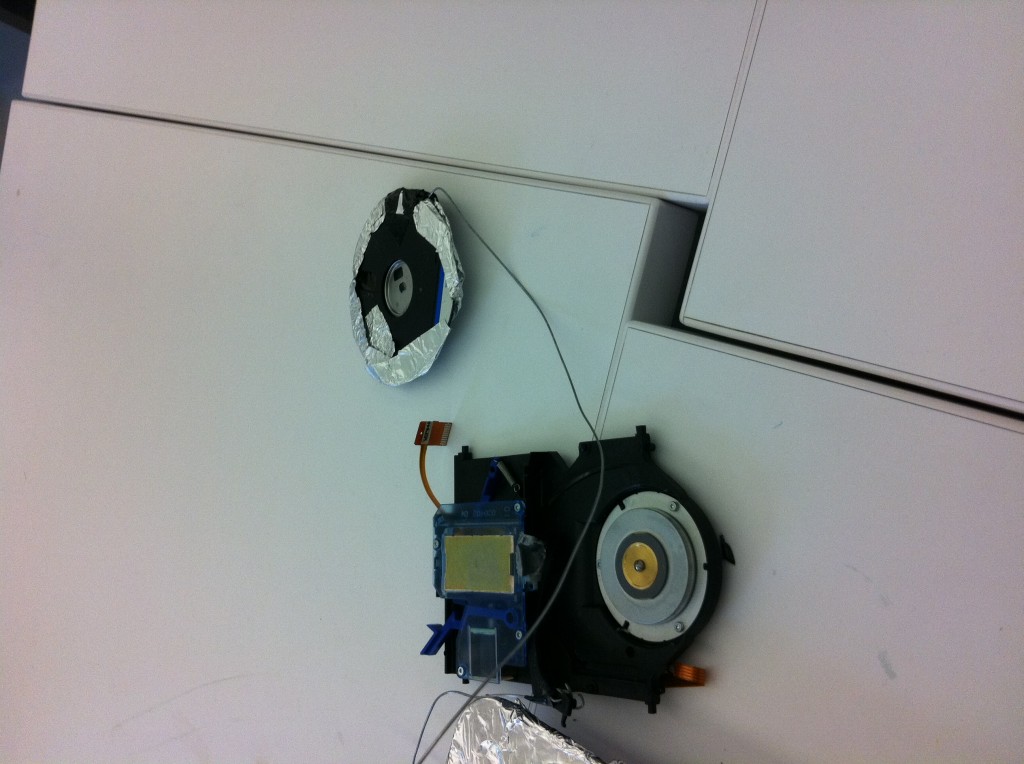 From the floppy drive we tore apart we got this cool little piece of junk that we decided to make it a dj turntable. Once we decided that we were going to make a dj turntable, we thought that we should make musical instruments for all of us and turn us into the worst band ever. We chose to make a drums, a guitar and a bass.
From the floppy drive we tore apart we got this cool little piece of junk that we decided to make it a dj turntable. Once we decided that we were going to make a dj turntable, we thought that we should make musical instruments for all of us and turn us into the worst band ever. We chose to make a drums, a guitar and a bass.
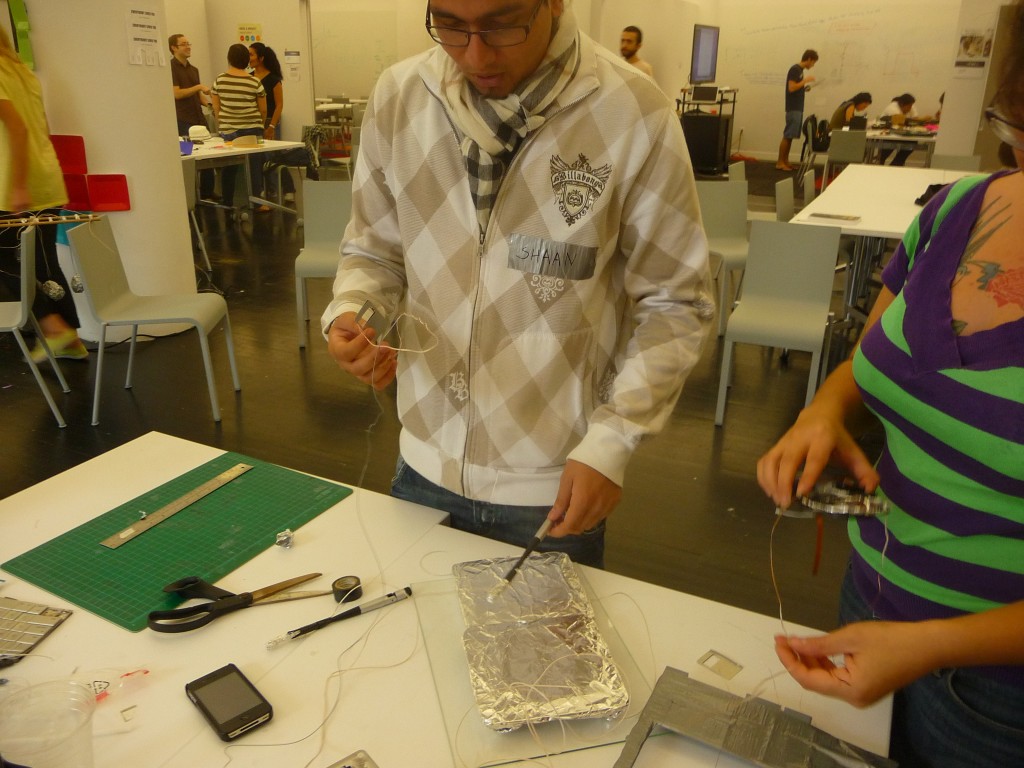 The drums were made completely from an old router that I tore apart. I used the covering of the router to make the drums and the antenna of the router to make the drum sticks.
The drums were made completely from an old router that I tore apart. I used the covering of the router to make the drums and the antenna of the router to make the drum sticks.

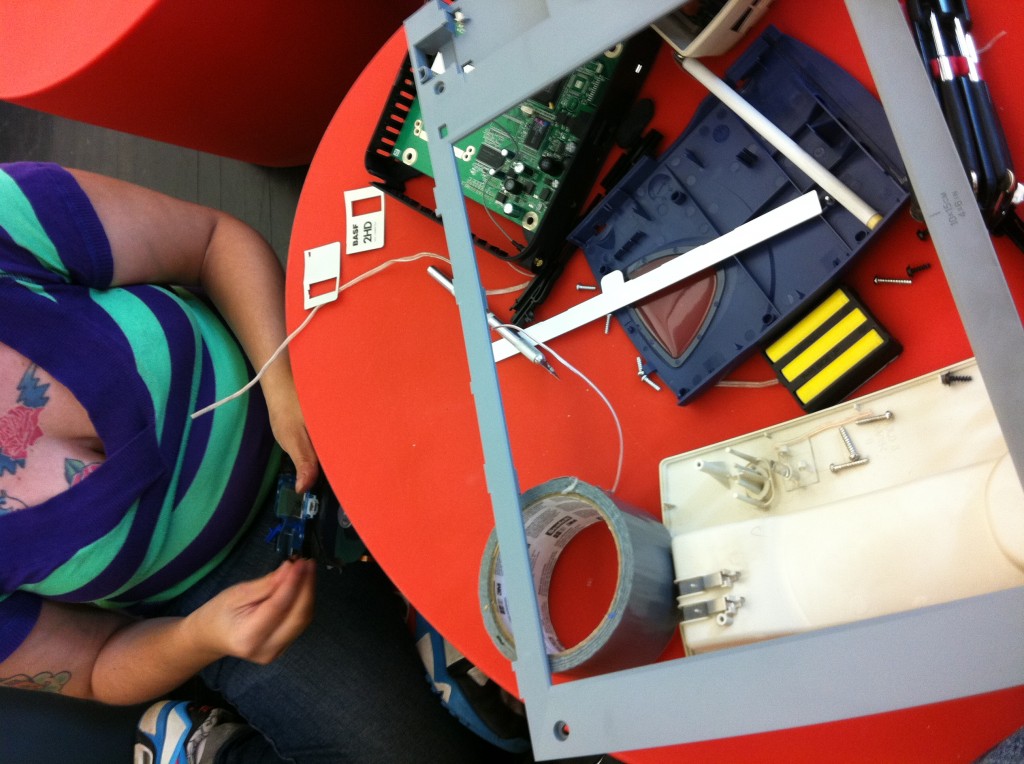 The guitar (which looked more like a harp) was made from the parts from the scanner. We took out the big plastic piece that held the glass in the scanner and put wires across it. Each wire made a different sound when hit with a pic that we fashioned from the metal piece on a floppy disk.
The guitar (which looked more like a harp) was made from the parts from the scanner. We took out the big plastic piece that held the glass in the scanner and put wires across it. Each wire made a different sound when hit with a pic that we fashioned from the metal piece on a floppy disk.
 The bass was made using the same techniques that we used to make the guitar. It was made out of the remains of the router. Instead of using a pick, we decided that we would wrap one of our fingers in foil and wire and play the bass with our finger.
The bass was made using the same techniques that we used to make the guitar. It was made out of the remains of the router. Instead of using a pick, we decided that we would wrap one of our fingers in foil and wire and play the bass with our finger.
 In the end we had a four person band rocking out some awesome tunes.
In the end we had a four person band rocking out some awesome tunes.
Mash Up – Arshaan
Software Mash Up:
When I started off with this project I knew I wanted to something that made a social impact. Before coming to New York I had stayed in Dubai for almost 7 years. One of the things that annoyed me the most back home was the fact that a lot of news is fabricated. Reporters are not allowed to report certain things. Most of the news just praises the city and the country. I know all of this because I had a friend who was a reporter for one of the big newspapers and she kept telling us about stories she could not write about. A lot of crimes, financial disasters and poor living conditions go unreported. When I decided to make a documentary on the living conditions of construction workers in Dubai I had to do it in utmost secrecy. This had to be done because if government officials found out I was doing this I would have gotten deported.
Coming back to my project, most of the population (including my family) only read the news produced in the country. There are many websites out there that publish the truth. I want people to know the truth and that is where my website ‘Get the truth’ comes in to play. It is a mash up of news websites. It grabs news articles from the local newspapers and compares it to articles that easily show the lies in the original article. The following sequence shows how the website works.
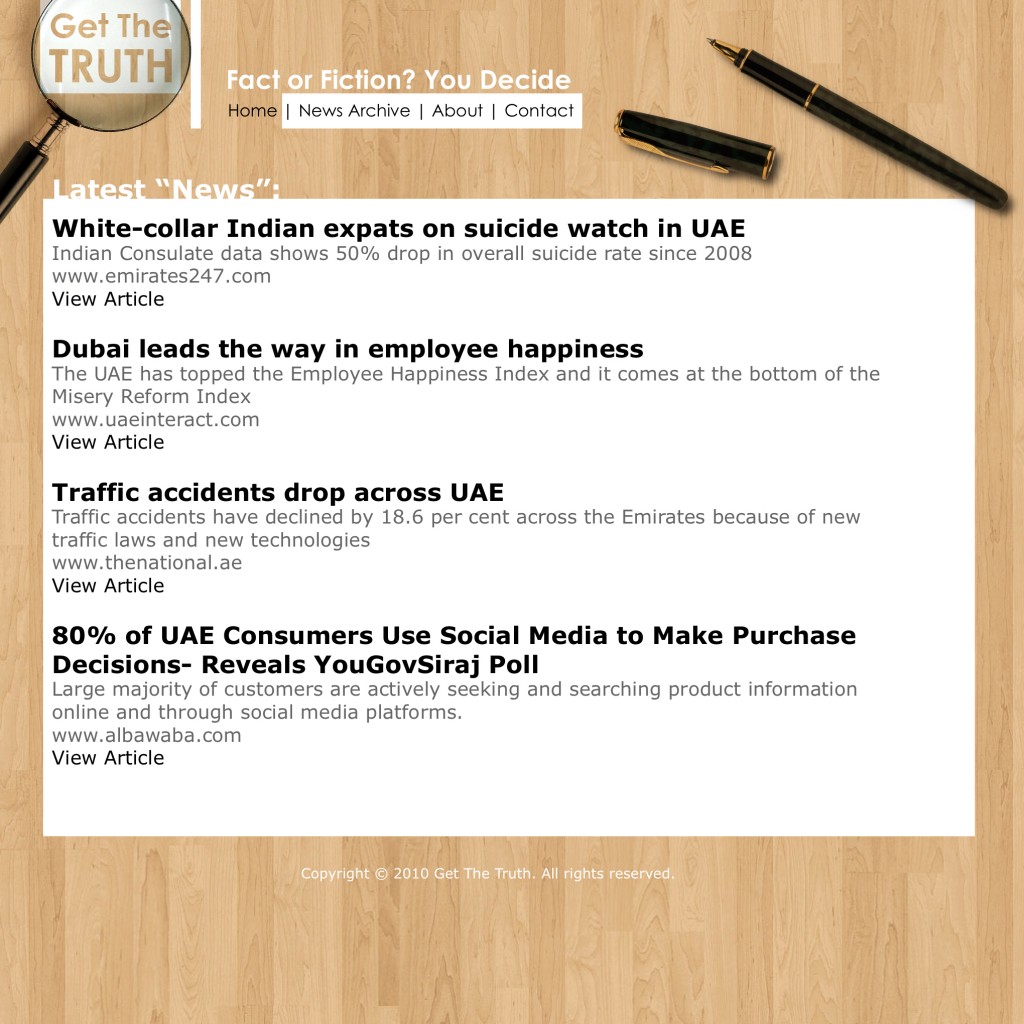 The home page shows all the latest news articles from local newspapers. Each article has a small summary describing what the article talks about. There are also links to a news archive where you will be able to find all the news articles.
The home page shows all the latest news articles from local newspapers. Each article has a small summary describing what the article talks about. There are also links to a news archive where you will be able to find all the news articles.
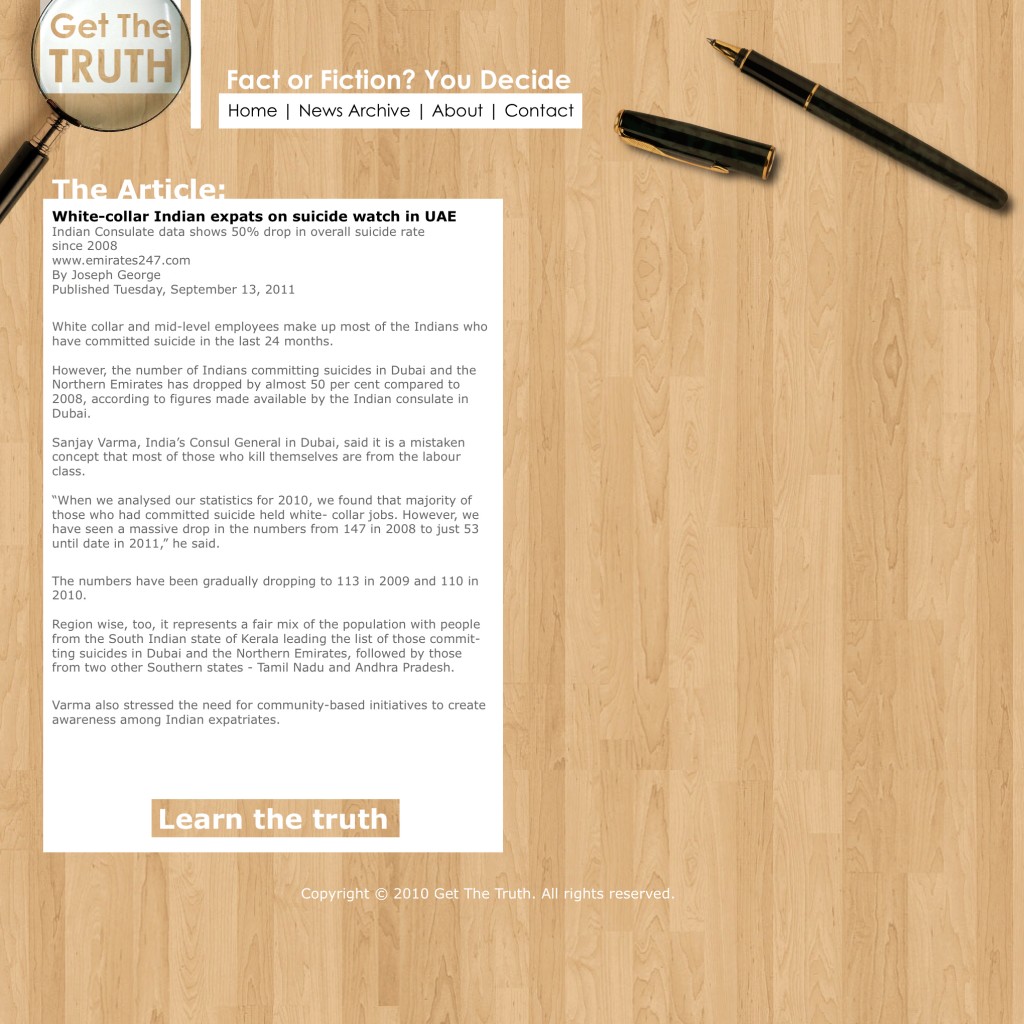 Once the user selects the article, the person is taken to a page where he can read the article. After reading the article the user can then choose to learn the truth. In the article I have chosen to show as an example, it speaks about how the suicide rate has dropped in the country.
Once the user selects the article, the person is taken to a page where he can read the article. After reading the article the user can then choose to learn the truth. In the article I have chosen to show as an example, it speaks about how the suicide rate has dropped in the country.
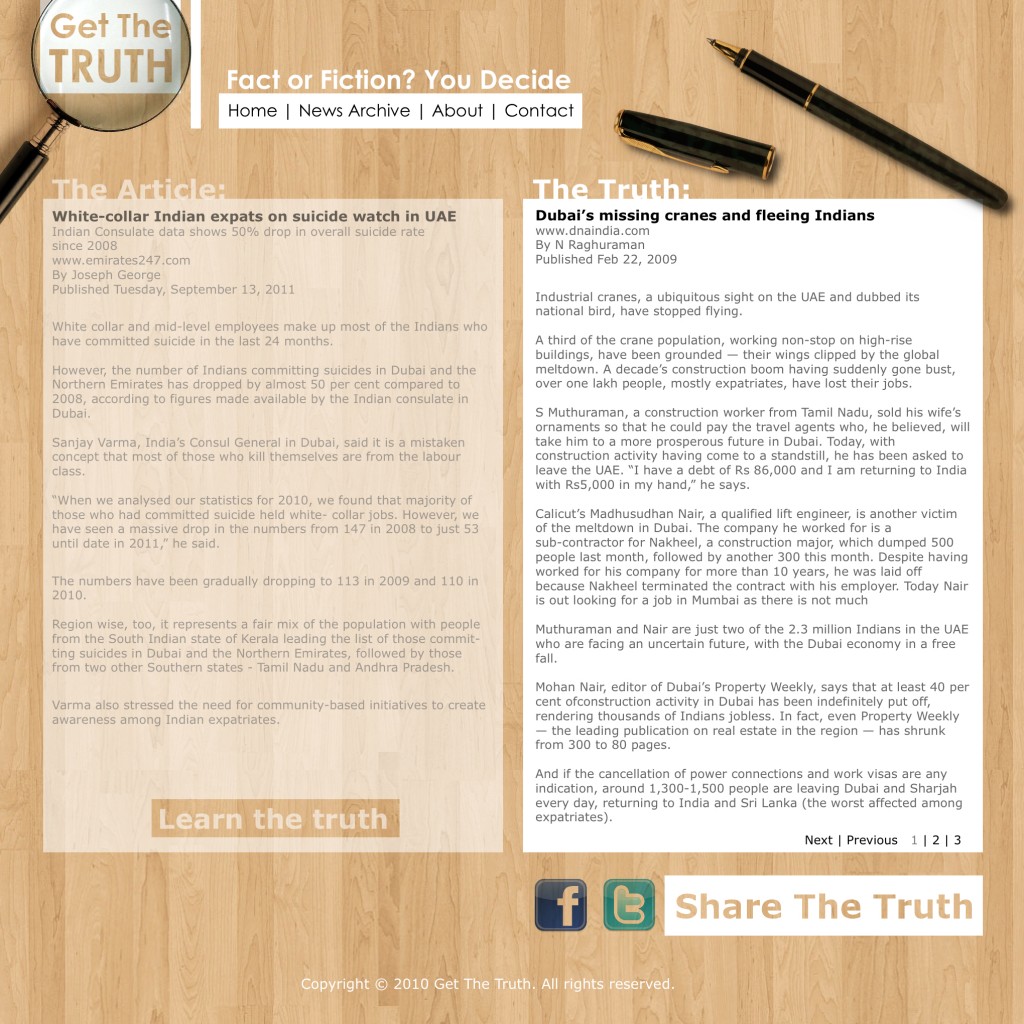 Once the user clicks on the ‘learn the truth’ button, the original articles fades a little bit in to the background and a new article from a different source shows up on the right. This article will try and show why the local article is a lie and there is nothing to take from it. In my example, the new article talks about how people have left the country thus explaining the drop in suicides. It has nothing to do with good working or living conditions. The user then has the option to share the truth if he believes in it.
Once the user clicks on the ‘learn the truth’ button, the original articles fades a little bit in to the background and a new article from a different source shows up on the right. This article will try and show why the local article is a lie and there is nothing to take from it. In my example, the new article talks about how people have left the country thus explaining the drop in suicides. It has nothing to do with good working or living conditions. The user then has the option to share the truth if he believes in it.
Hardware Mash Up:
For this mash up I originally wanted to do something environmental. I planned to show the problems of global warming by making an internet based game that affected ice cubes in some way. However, with time running out and with no solution I decided to have some fun with this project instead. I started off as a marketing student in my undergrad and decided to make a marketing gimmick that would be part of a bigger marketing plan.
My website here is called ‘Think Stink’ and it would be used to promote air fresheners or deodorants. It would be implemented in work location or schools/universities. Whenever someone enters a ‘stinky’ persons name in the website, air fresheners placed in pre-determined locations will go off. The website will also have a leaderboard system where people with more votes will be placed higher up the leaderboard. The leaderboard is used to give people a reason to return to the website. The website states that everything should be taken as a joke. The following sequence of images explains how this would work.
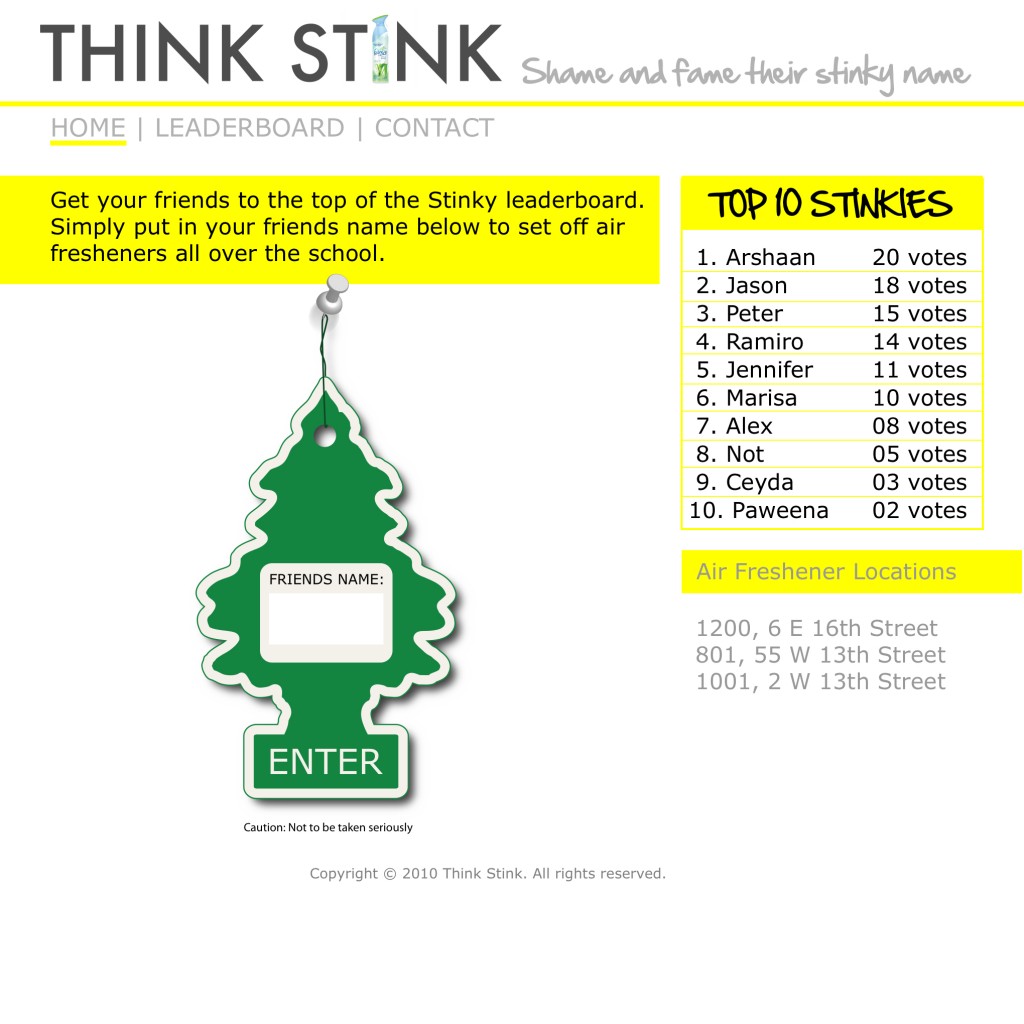 The home page gets straight to the point. It tells the user what is supposed to happen if they put in a friends name. It also contains the top 10 people in the leaderboard and the locations of the air fresheners.
The home page gets straight to the point. It tells the user what is supposed to happen if they put in a friends name. It also contains the top 10 people in the leaderboard and the locations of the air fresheners.
Once the user enters a persons name, the air fresheners in the locations will go off. This promotes the use of the air freshener as these highly crowded locations will start to smell good. There is nothing wrong with a nice smelling work place right?
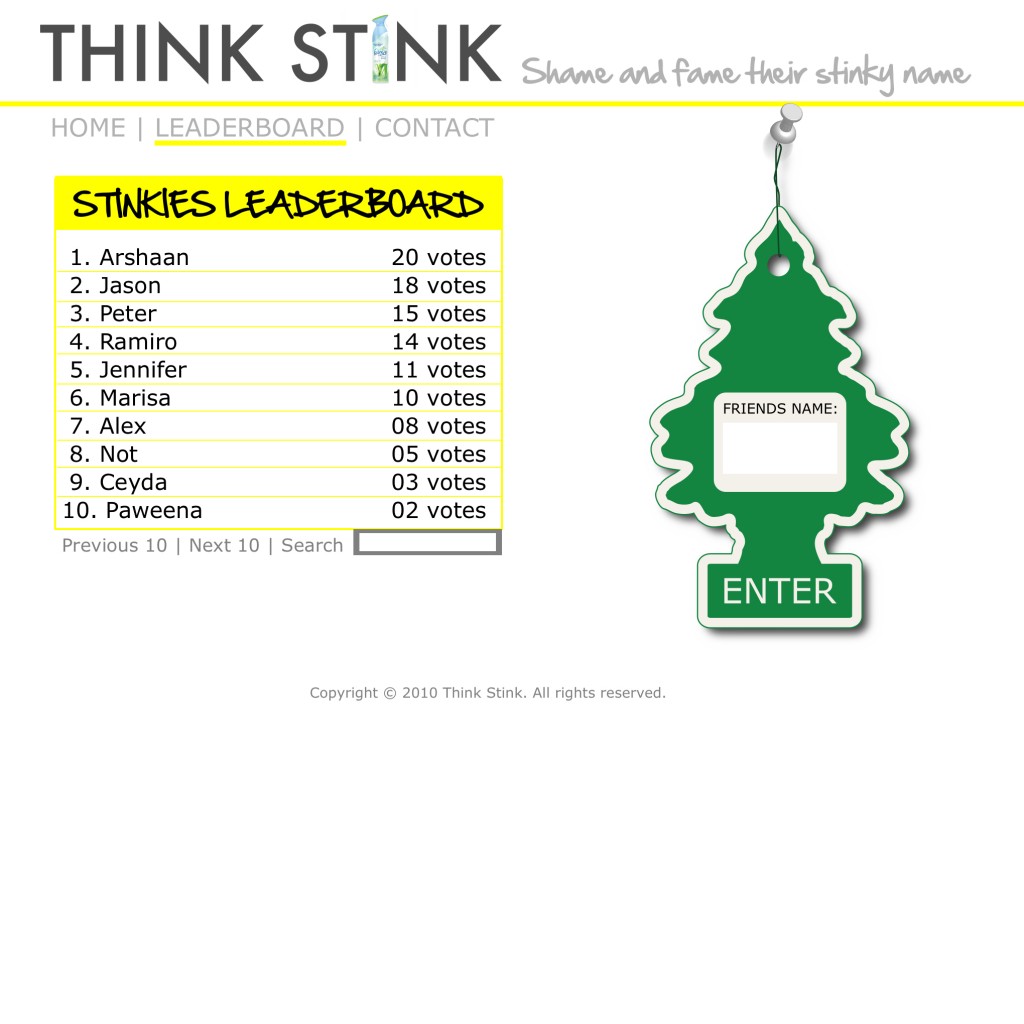 The user can also visit a page dedicated to the leaderboard where they can see how high up they are located in it or where the friend they are pranking is located. The user can also enter a friends name on this page.
The user can also visit a page dedicated to the leaderboard where they can see how high up they are located in it or where the friend they are pranking is located. The user can also enter a friends name on this page.
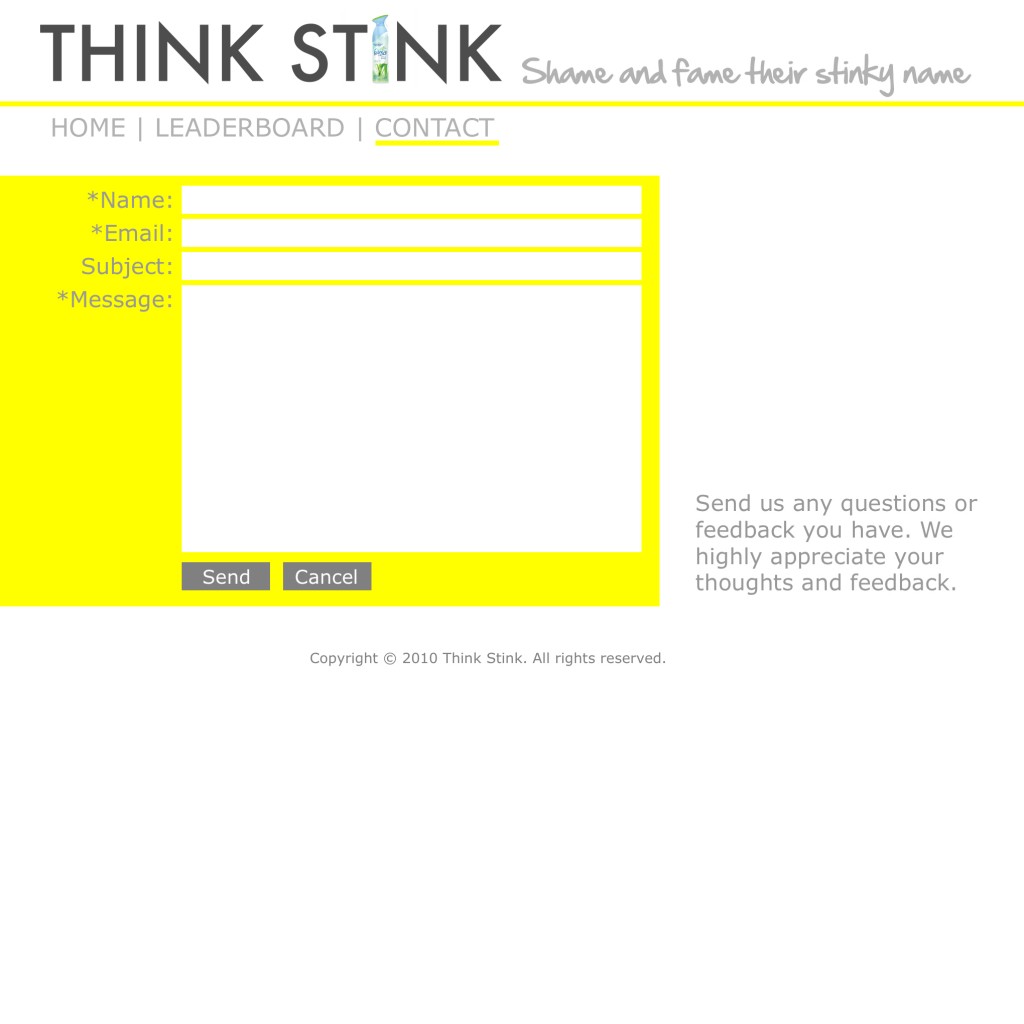 The last page is a basic contact form where users are encouraged to provide their feedback.
The last page is a basic contact form where users are encouraged to provide their feedback.
Scrapyard Challenge – Alex S
We salvaged a 1974 GE portable turntable, dc motor, and some test tubes. What we made, or rather, attempted to make, was a rotary sequencer.
Check out our flickr photostream.
Check out our video.
MashUp – Alex S
Hardware MashUp
This physical mashup was intended for those of us who are master of procrastination and disasters of organization.
The concept, is a physical to-do reminder, that sits near you and perpetually reminds you of your to-do list. Many of us have a great deal to do in a short amount of time. It is difficult to stay on track and keep on top of your work. The to-do reminder has set out to remedy this, and reduce your hours of procrastination. Ideal for students!
How do I add a to-do to my list? There are two ways. One, any time you are online you can visit our URL (currently being tested at fuzzywobble.com/todo/) and append/edit your to do list through a quick and easy online form. Two, text your to-do from your cell phone to our number and it will automatically be added to your list.
How do I see my to-do list? Your list is displayed as scrolling text on a small LCD which is part of the compact and wireless device. The device may just be some little bot with an LCD head as shown below…
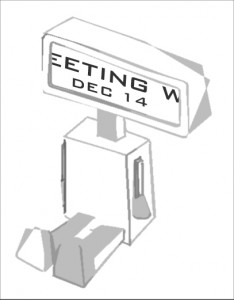
A prototype is currently being developed for this product.
Software MashUp
It is difficult to develop ingenious ideas in an area already so saturated. Because of this I began thinking wildly about mashup concepts that could be possible in the future. I arrived at an absolutely mental and outlandish concept titled AnotherMe.
Simply put, AnotherMe enables you to find other people on the planet most like you through a monstrous mashup algorithm. It was conceived when I observed the ever increasing trend of both the number of people online, as well as the number of people avidly sharing personal information. When every human on the planet is online, and you and one amongst (what could be) ten billion people, are you going to be overly concerned with privacy?
I compiled a list of items I feel can accurately distinguish a human…
Age Geographic locations, past and present Interests and hobbies Linguistics Character and demeanor Physical appearance Views, political and religious Genetic traits and DNA Societal status/role Ambitions Health Achievements or misfortunes
With exception to health, character, DNA and misfortunes, most of these are already shared online by younger generations who have access to technology.
For this project I envisioned a future where personality can be captured and accurately stored in an accessible online database. DNA and health information is also shared through privatized databases. As we can suspect, access to this mass of information would lead to an unusual and somewhat scary future for mashups.
Scrapyard Challenge Fall 2011: The Making of the “MJ Switch”
MIDI? Switches? Musical Controller? These are all words that I would never have put together before my participation in the Scrapyard Challenge workshop. Working with found “junk” was a challenge that not only tested technical skill and understanding, but also creativity. Scrapyard Challenge would not have been successful if we did not use our imagination. From the beginning when we looked at piles of stuff that people brought in, our role as the designer began as we started to think how to create a prototype of a working musical controller.
Our project began with a pile of random unused, unwanted materials. With no initial ideas in mind, my group started by claiming objects we thought could possibly be interesting. We gathered a couple of things and took it back to our table to investigate and analyze. As we looked at what we had and started to think of different ideas, we found one object that had a lever that moved up and down, as well as a forward and back motion. We decided to use these motions to our advantage and create connections between them, allowing us to have two sounds.
The object we started with quickly changed from “junk” to a prototype for a musical switch. As defined by Stephanie Houde and Charles Hill in “What do prototypes, Prototype?” a prototype is a way of exploring and expressing designs, as well as the “role the artifact play[s] in a users life.” We were working with an object that allowed us to explore its functionality as well as expressing it in a new way. As we designed how it was going to work, we also had to think about how others would interact with our new creation. Since it was not just about creating something that functioned, it was also about creating a pleasing interface. As we continued to work, our goals became clear: making something that worked and also looked worthy of interaction.
First, we had to tackle technical issues. Since our whole mechanism was made of metal, we needed to insulate specific parts so we could keep each interaction separated. In order to do this we used cardboard, hot glue, and masking tape. The task became tricky when we started to include the wiring. Although we were just creating a prototype it would not be nice to just create something with wirings coming out of everywhere. So in order to avoid this, we carefully placed the wires in places that kept them together and on the sides of the mechanism. Throughout the process of wiring our prototype we resolved problems that came up and made design decisions along the way.
After we got the sound connections to work, we needed to work on the interface. How do we let people know they can interact with what we created? To do this we used small plastic hands that came from mini-noisemakers. We attached one to our push lever and another to the side. Now it looked liked our device had hands. If it had fans, then it definitely needed a face. We searched for a microchip board and found one that would fit. While gluing this on, we realized the middle section could rotate. In an attempt to solve this problem, we re-wired the motor, but it was not powerful enough to work. That’s when we decided it needed to become an analog rotation. To create a connection so we could now make a third sound, we foiled one hand and gave our face “hair” (shredded wire), which led to a successful third connection to make an additional sound. So here, in the process of creating a prototype, we were able to add more to our interactions.
The final product was what we called the “MJ Switch,” with a reference to Michael Jackson since our mechanism wore a foil “glove” on one hand. The evolution of our prototype was possible because while making all of the technical connections work, we also kept in mind the final look. If we did not decide from the beginning that one of our goals was to create something that was inviting for the user, we could have made a controller that had lots of connections and sounds. But instead, I believe our device was a success because we kept our goals in mind, which ultimately influenced our design decisions.
This experience and process of starting from nothing and creating an object (with a personality!) taught me a lot about the design process as well as the importance of having an open mind. Being put into this situation, we were tested on how creative we could be from turning “use-less” objects into something “useful.” This was a test of my creativity as well as skill. In the end, three heads were better than one, and working in a group allowed us to throw out ideas, and although one person may not have been able to solve problems on their own, we could work together as a team. At times, we each played a different role. Sometimes, one person had an idea, and another person executed the technical mechanics. As this went on, someone else would keep in mind the final look. We were a little prototyping team, who thought about the role, implementation and look and feel of our final device.
We had problems, but we discovered solutions. Our prototype went through a few stages that finally lead to a working model. We really did not have to think much about creating new things, but we worked a lot with what we already had. We don’t know where our mechanism originated from, but the levels and movements worked perfectly for our challenge. At the end of the day we successful created a working prototype of our “MJ Switch” that allowed us to make music.
Scrapyard Challenge!
Scrapyard Challenge
September 25, 2011
Our team (Galina, Yong, Jason) decided to make a musical sailing ship entitled “Sound Wave.” In the beginning, we just started to tear apart junk in order to find some useful parts. All three of us wanted to make something that spun therefore we picked out a CD player. Unfortunately, although the time display and radio was working, the cd rotation did not work. We wanted an automated rotation but because parts were indeed from junk, the cd rotation motor seemed to have broke. Since then, we changed our concept so that – when in best-case scenario – the wind would be able to control the “sail” of the boat.
As seen on the picture above, random wires attached to the CD. These wires were connected to the power through aluminum foil and solder. The wire on the yellow tube would provide the input for the MIDI device and make sounds as the wire touched the wires on the CD. The two wires attaching would basically serve as the switch.
Because we wanted to create more musical notes, we decided to put a more wires grew out of the cd. As seen in the picture above, we color-coded the green and purple wires to make two other sounds. As the CD turned, this would not only affect the movement of wires on the CD, but would also affect the green and purple wires to create more crazy music!
This is the finished result of the “Sound Wave.” It has three different inputs color-coded yellow, green, and purple.
The inputs would be connected to the blue wires while the power source was connected to the red wires.
It was really fun playing around with junk. At first, i was thinking to myself if I could actually get junk to produce music. I realized the power of aluminum foils, wires, and solders. It was very fun to think of other methods of switches and to make totally random music!
Below is the video link of our Sound Wave working. You can’t really hear our sound because the video was taken during the huge music jam session.
Scrapyard Challenge 2011 Parsons DT

For the scrapyard challenge I teamed up with Peter Chang, I-Shan Naomi Lin, and Wen Ching to build a robot. Initially I made a robot that was about 12 inches tall, however it ended up being too heavy to move on the motorized ball. So we decided to cut the bottom of the robot and see if that would fix the problem. Unfortunately it was still too heavy to move so we cut a bit more and a bit more…. and yet it still weighed too much. As a result of this discovery in the process the team opted to create a smaller robot. We created a bride and groom and an aisle with an obstacle course. The grooms mission was to meet the bride and on his way he would come in contact with pillars of tin-foil. The area box was covered in tin-foil so it was conductive and the groom was wired so that every time he hit a wall or pillar a noise/music was made. Check out the Vimeo video of our final presentation and project. I compiled a video documenting the progress of my project and my peer’s work. You may view the video of our Scrapyard project on Vimeo. There is also an album on FlickR that captures our project from start to finish. View my FlickR album of Scrapyard Challenge 2011 Parsons DT
Scrapyard was a fun project and I ended up creating something fun from junk.
Scrapyard Challenge documentation
Here is my documentation of Scrapyard Challenge workshop. The overall experience that day was really great! I guess everyone had an amazing time like me as well!

